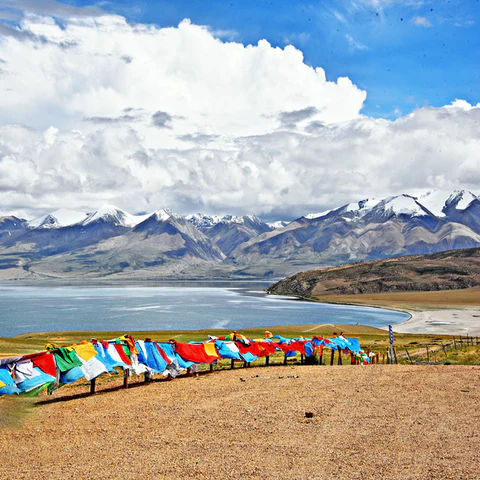- Mon - Fri:
9:00am – 9:00pm
- Call Us:
+1-702-268-6636
- Language:
English
- Currency:
$USD
+1-702-268-6636
English
$USD





Follow us to learn more about energy growth
Tibet—mysterious, majestic, and deeply spiritual—is often called the “Roof of the World”. Governed as an autonomous region of China, this remote, high-altitude land is not just a place on a map, but a destination etched into the hearts of travelers, pilgrims, and dreamers. It is the source of mighty rivers, the cradle of ancient wisdom, and a sanctuary where faith and nature exist in perfect harmony.
Whether you’re seeking peace, inspiration, or a deeper connection to something greater, Tibet calls to the soul. In the scent of burning incense, the warm smiles of devout Tibetans, and the silent watch of snow-capped peaks, you feel it—this land is sacred.

For some, Tibet is an ancient dream waiting to be fulfilled.
For others, it is a cherished memory or a spiritual calling.
To wanderers, it is a place of endless wonder and transformation.
In this article, let’s explore some of the most sacred and awe-inspiring places that make Tibet a spiritual home for so many.
Towering within the Gangdise Mountains, Mount Kailash is revered by four major religions—Tibetan Buddhism, Bön, Hinduism, and Jainism—as the spiritual axis of the universe. Known in Tibetan as the “Mountain of the God of Snow,” it is not just a mountain, but a divine presence.
Pilgrims believe that completing a kora (ritual circumambulation) around Mount Kailash can cleanse a lifetime of sins. Its snow-draped peak remains untouched—climbing it is considered sacrilege.
Set against the bright blue skies of Lhasa, the Potala Palace rises like a dream. Built during the Tubo Dynasty for the union of Princess Wencheng and Songtsen Gampo, this towering palace is the highest of its kind in the world.
Combining sacred temple, royal residence, and fortress, it remains a powerful symbol of Tibetan Buddhism. Every year, pilgrims from across the plateau walk for miles—prostrating at every step—to stand before this icon of faith.
Known globally as Mount Everest, this peak needs no introduction. Rising 8,844 meters above sea level, it straddles the border between Tibet and Nepal. In Tibet, it is more than just the world’s tallest mountain—it is a sacred guardian.
Tibetan pilgrims see Qomolangma as a holy mountain and often visit its base to offer prayers, meditate, or simply gaze in awe. It is a place where heaven meets earth, and the soul feels small yet uplifted.
Nicknamed “Eastern Switzerland,” the region of Nyingchi offers a gentler, greener side of Tibet. At the Mila Mountain Pass (5013m), prayer flags flutter in strong mountain winds, carrying blessings to the heavens.
Snow-capped peaks, alpine forests, and crystal-clear rivers come together in a picture of pure tranquility. Nyingchi is a hidden gem where nature and spirituality bloom side by side.
High in the Qiangtang Grassland lies Namtso, the “Heavenly Lake.” As the highest saltwater lake in the world and one of Tibet’s three sacred lakes, its deep blue waters shimmer like a sapphire under the vast sky.
Pilgrims walk around the lake’s perimeter, seeking spiritual purification. For visitors, Namtso offers silence, reflection, and a deep sense of being one with the elements.
Perched on a cliff in Zanda County, the Guge Kingdom Site whispers stories of a once-glorious civilization. The remains of palaces, temples, and mural-adorned halls speak to a rich and mysterious past nearly a thousand years old.
Recognized as a national cultural heritage site, Guge is a place where history meets myth, and the echoes of a forgotten empire still linger in the wind.
At the eastern tip of the Himalayas lies Mount Namjagbarwa, rising to 7,782 meters. Wrapped in clouds and revered as the “Father of All Tibetan Mountains,” it is a deeply sacred site in the ancient Bön religion.
Often hidden from view, those lucky enough to see its peak believe they’ve been blessed. It is a symbol of mystery, power, and spiritual awe.
Tibet is not just a destination—it is a soul journey.
Amid snow-capped mountains and serene lakes, under fluttering prayer flags and beneath star-studded skies, Tibet calls us to pause, reflect, and reconnect. It is a place where time slows, the heart opens, and the sacred becomes visible.
In a life that offers no rewinds, Tibet is where we go to live fully, freely, and consciously.
To stand in the silence of the Himalayas…
To walk alongside devoted pilgrims…
To breathe the incense-scented air…
This is not travel—it’s transformation.
“One should go to Tibet at least once in a lifetime—to feel what it means to be close to heaven.”
